by Maxine Carter-Lome
When we think of the Wild West and the pioneers who set out for parts unknown after the Civil War, our reference is the American Cowboy. While a cowboy’s life was a hard one, living freely on America’s western frontier nevertheless appealed to thousands of men who left their homes in search of adventure and opportunity. But they were not alone on the western frontier. Women, too, made a name and life for themselves. Some could shoot and ride as well as or better than many of their male counterparts. Here are ten famous cowgirls, outlaws, and gunslingers who broke barriers and made a living—honestly and dishonestly—by their horses, their guns, and their wits.
Annie Oakley (1860 – 1926)
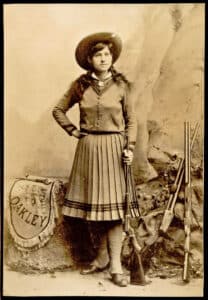
Widely known as “Little Sure Shot” Oakley, Annie Oakley, born Phoebe Ann Mosey, grew up to be an incredible sharp-shooter and world-renowned master of dangerous trick shots. At 30 paces she could split a playing card held edge-on, she hit dimes tossed into the air, she shot cigarettes from her husband’s lips, and as a playing card was thrown into the air, she riddled it before it touched the ground. At the height of her fame, Annie was a headliner in Buffalo Bills’ Wild West show, which she joined in 1885 with her husband, Frank Butler. Oakley’s worldwide stardom as a sharpshooter enabled her to earn more money than most of the other performers in the Buffalo Bill Show.
Annie Oakley was also an advocate for women fighting in combat. Throughout her lifetime, she passed on the art of shooting to more than 15,000 women. Her desire to teach the ladies of the day how to “… handle guns as naturally as they know how to handle babies” was more than a century ahead of its time.
In 1901, Oakley was badly injured in a train accident but recovered after suffering temporary paralysis and enduring five spinal operations. She left the Buffalo Bill show and in 1902 began a less taxing acting career in a stage play written especially for her, The Western Girl. Oakley played the role of Nancy Berry who used a pistol, a rifle, and rope to outsmart a group of outlaws.
Moving in and out of retirement, Annie kept shooting. She and Frank gave much of their earnings to orphanages as they remained childless. She passed away in 1926 at the age of 66 followed by Frank just 18 days later.
A vast collection of Oakley’s personal possessions, performance memorabilia, and firearms are on permanent exhibit in the Garst Museum and the National Annie Oakley Center in Greenville, Ohio.
Calamity Jane (1856 – 1903)
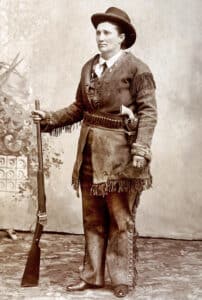
Buffalo Bill’s Wild West Show also featured another, much less agreeable cowgirl known as Calamity Jane. With questionable character, boldness, and the ability to captivate, Calamity Jane was a woman of all trades.
In 1865, Martha “Calamity” Jane Canary traveled from Missouri to Virginia City, Montana, on a five-month-long wagon trail. This teen spent most of her time hunting with the men in the caravan and became a good markswoman and fearless rider.
Upon completing the journey, Jane lost her mother and one year later, her father. She and her five siblings arrived at Fort Bridger in 1868 doing whatever job they gave her. In 1870, she joined General George Armstrong Custer as a scout at Fort Russell, Wyoming, donning the uniform of a soldier. This was the beginning of Calamity Jane’s habit of dressing like a man.
While working and traveling with the military, Jane earned her nickname after a Native American ambush where she daringly rode to and then lifted Captain Egan, who had been shot and fell onto the ground, up onto her horse to get him back to the Fort. Upon recovering, the Captain laughingly said, “I name you Calamity Jane, the heroine of the Plains.” In her own words, Calamity would later say of this time, that she was the most reckless and daring rider and one of the best shots in the West.
By the late 1870s Calamity Jane had captured the imagination of several magazine-feature writers who covered the colorful early days of Deadwood, South Dakota, one of the liveliest mining camps in the country after gold deposits were found, which led to the Black Hills Gold Rush. One dime novel dubbed her “The White Devil of the Yellowstone.”
Having the reputation for being able to handle a horse better than most men and shoot like a cowboy, her skills took her into Buffalo Bill’s Wild West Show in 1895 where she performed sharpshooting astride her horse.
It is said she was the lover of “Wild Bill” Hickok, avenged herself on his killer, and bore his secret love child. She did follow him into Deadwood where she worked as a Pony Express rider and was there when Hickok was shot dead at the Nuttall & Mann’s 66 Saloon.
Calamity lived up to her moniker by being a hard-drinking, sure-shooting, opinionated, and surprisingly caring Western woman who exaggerated her own tales to anyone who would listen. In August of 1903, Jane was dying in a room at the Calloway Hotel near Deadwood. Her last request was to be buried next to Wild Bill on Mt. Moriah.
Belle Starr (1848 – 1889)

Possibly the most notorious female outlaw and gunslinger of the Wild West was Belle Starr.
Born in 1848, Myra Maybelle Shirley Reed Starr was a classically educated young lady whose life turned upside down following a Union soldier attack at her family’s home in the early American Civil War. It is said her brother John A. M. “Bud” Shirley traveled with guerilla bands to act against the Union soldiers and that Belle supported his efforts by spying for the self-named “buccaneers.” Bud Shirley was killed by federal troops in late June 1864.
Soon after the attack, her family moved to Texas where Belle married her first husband, James C. Reed, and had two children. It was Reed who got involved with criminal gangs and associated with the Starr clan, a Cherokee family known to commit crimes involving whiskey, cattle, and horse thievery. They also got involved with the James and Younger gangs. James Reed was killed in 1874 in Paris, Texas and Myra moved on after returning to the Starr gang.
In 1880, she married a Cherokee man named Sam Starr and settled in the Indian Territory. There, Belle learned ways of organizing, planning, and fencing for the rustlers, horse thieves, and bootleggers, as well as harboring them from the law. Belle’s illegal enterprises proved lucrative enough for her to employ bribery to free her colleagues from the law whenever they were caught.
Among other things, Belle was arrested for horse theft twice but convicted only once. She always harbored a strong sense of style, which fed into her later legend. A crack shot, she used to ride sidesaddle while dressed in a black velvet riding habit and a plumed hat, carrying two pistols, with cartridge belts across her hips. Ultimately, her felonious lifestyle led to the loss of her husband in a gunfight.
On February 3, 1889, two days before her 41st birthday, Belle was ambushed and killed while riding home from a neighbor’s house. Her death resulted from shotgun wounds to the back and neck and in the shoulder and face.
Legend says she was shot with her own double-barrel shotgun.
Although she was an obscure figure outside Texas throughout most of her life, Belle’s story was picked up by the dime store novel and National Police Gazette publisher Richard K. Fox, who made her name famous with his fictional novel Bella Starr, the Bandit Queen, or The Female Jesse James, published in 1889 (the year of her murder). This novel is still cited as a historical reference despite its artistic license and lack of historical accuracy. It was the first of many popular stories that used her name.
Pearl Hart (1871 – 1955)
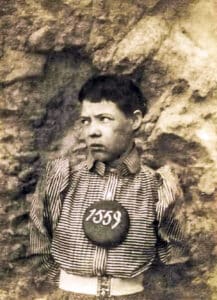
Another of the infamous ladies of the Wild West was a cowgirl named Pearl Hart, who liked to dress as a man, with hair shorn, and arm herself with a .38 revolver.
Born Pearl Taylor on Canadian land in 1871, this nineteenth-century outlaw, the so-called “Bandit Queen,” is most well-known for committing some of the last stagecoach robberies in the United States.
Together with her accomplice “Joe Boot,” Hart committed crimes like there was no tomorrow. On one occasion, Hart and Boot were on the run when the sheriff caught them sleeping by the posse and took them into custody. According to eyewitness accounts, Hart fought like a cat but to no avail. Hart was eventually convicted of interference with the U.S. mail and served a five-year sentence for her infamous crime.
Hart was sent to Tucson to a facility for women, where she escaped on October 12, 1899, taking advantage of the relatively weak building material, and possibly with the aid of an assistant, leaving an 18-inch (46 cm) hole in the wall.
The novelty of a female stagecoach robber quickly spawned a media frenzy and national reporters soon joined the local press clamoring to interview and photograph Hart. One article in Cosmopolitan said Hart was “just the opposite of what would be expected of a woman stage robber,” though, “when angry or determined, hard lines show about her eyes and mouth.”
Hart later joined Buffalo Bill’s Wild West Show under an alias. In addition to being a staple of pulp western fiction, Hart’s exploits have been featured in other venues, including the play Lady with a Gun and the musical The Legend of Pearl Hart, both based upon Hart’s story.
Laura Bullion (1876 – 1961)
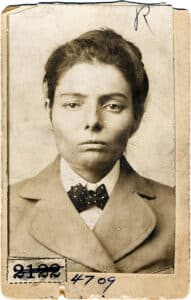
Born in Knickerbocker, Texas around 1876, Laura Bullion was a notoriously wicked woman of the Wild West. Her rather feminine aliases made a sharp contrast with her masculine face and tendency to wear men’s attire.
Bullion’s father had been a bank robber, so it came as no surprise when Laura followed a life of crime. His acquaintance with outlaws William “News” Carver and Ben Kilpatrick (“The Tall Texan”), introduced his young daughter to men she would go on to have romantic relationships with; first William Carver when she was just
15 years old, and, following his death by lawmen in 1901, transferring her affections to Ben Kilpatrick.
Bullion was also a member of Butch Cassidy’s Wild Bunch gang. The Wild Bunch was a loosely organized group of bank and train robbers based in Wyoming. Members of the Wild Bunch nicknamed Laura Bullion “Della Rose,” a name she came by after meeting Kid Curry’s girlfriend Della Moore. Often, Bullion was referred to as the “Rose of the Wild Bunch.”
Bullion took part in several train robberies with the Wild Bunch and helped the gang by fencing goods and money. Eventually, the law caught up with her in Saint Louis, Missouri, where she was convicted of playing a part in the Great Northern Train Robbery. According to a New York Times article, she was “masquerading as ‘Mrs. Nellie Rose’” at the time of her arrest. For her crime, Laura served three years in prison.
Upon her release, Bullion lived the last years of her life in Memphis, Tennessee, under the name of Freda Lincoln, making her way as a seamstress and dressmaker.
Goldie Griffith (1893 – 1976)

One of the toughest, albeit lesser-known cowgirls of the Wild West was Goldie Griffith. Goldie joined a small group of showgirls working with Buffalo Bill.
Hired without knowing how to ride a horse, Goldie soon learned to bust broncos for the show. Fuelled by her newfound skills, she also began working as an actress and stunt rider in Western movies.
On one particular Wild West Show, an astonishing crowd of 8,000 witnessed her tie the knot with Hiram Joseph Sterling. The couple had one child, although their marriage found a gruesome end.
When Goldie’s husband crossed her one day, she opened fire on him with her shotgun in public.
Throughout her life, she was constantly breaking barriers. She even made history by becoming the first female applicant for the San Francisco Police Department!
Eleanor Dumont (1829 – 1879)
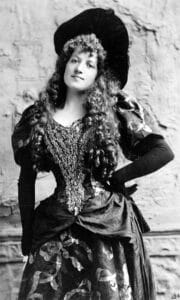
“Madame Eleanor Dumont” arrived in Nevada City, California in about 1850, she was a well-known gambler and prostitute living in the American West during the great California Gold Rush. Later in life, she was also known by her nickname Madame Moustache due to the appearance of a line of dark hair on her upper lip.
Excited by the opportunity to reinvent herself on the untamed frontier, Eleanor claimed to be French when she first arrived in California in 1850. She was actually of French-Creole descent with family roots in the city of New Orleans, Louisiana.
Madame Moustache soon became an accomplished card dealer and was skilled at winning the hard-earned cash of men. Wasting no time, Eleanor opened a gambling hall called “Vingt-et-un” (“21”) on Broad Street in Nevada City, California. The classy establishment was a huge success and attracted customers from up and down the country. Madame Moustache was not only a remarkable gambler but also a talented businesswoman. She was able to sell and rebuild gambling establishments as the local economies changed, dictated by the flow of gold.
Dumont added prostitution to her repertoire during the 1860s when she became the madam of a brothel. She kept brothels in many of the cities she visited as a gambler. To promote her business, she paraded her employees around town in carriages, showing off their beauty in broad daylight, much to the dislike of non-prostitute women.
In 1877, a Deadwood reporter would say of her: “A character who attracts the attention of all strangers is ‘Mme. Mustache,’ a plump little French lady, perhaps forty years of age, but splendidly preserved. She derives her name, which is the only one she is known by, from a dainty strip of black hair upon her upper lip. She deals her own game and is quite popular with the boys, who treat her with marked respect.”
Upon losing a bet with a higher loss than she could afford, Madame Moustache was found dead of suspected suicide by morphine overdose as reported by The Bodie Morning News on September 9, 1879.
Mary Fields (1832 – 1914)
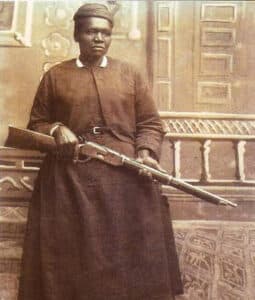
Mary Fields was a pioneer of the Old West as the first female African-American Star Route mail carrier. Born in Tennessee, she is also known as “Black Mary” or “Stagecoach Mary.”
At the age of sixty, Mary Fields applied to work for the US Postal Service. She impressed the recruiter by being the fastest to hitch up her six-horse team and was hired.
Not long after starting work, Mary gained a reputation for being hard-working and reliable. In eight years, she did not miss a single day’s delivery. There were even occasions when she carried the mail on her back in poor weather to maintain her route.
A true role model for empowered women, Mary even tried her luck at restaurant ownership. Unfortunately, she went bankrupt within a year as she would serve anyone food whether they could pay for the meal or not. Mary also became one of the only women permitted in Montana saloons thanks to a special boon granted by the Mayor of Cascade.
Rose Dunn (1878 – 1955)
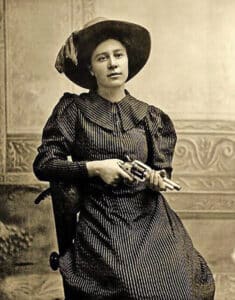
Rose Dunn, known as “The Rose of Cimarron,” was a famous outlaw who learned to rope, ride, and shoot thanks to her two older brothers. They also inadvertently introduced their formally educated sister into a life of crime.
As the years went by, Rose’s older brothers turned to bounty hunting. Meanwhile, Rose became romantically involved with and a loyal accomplice of George Newcomb’s Wild Bunch gang when she was just 14 or 15 years of age, and regularly ran errands for the group.
In September of 1893, the gang was cornered by a posse of U.S. Marshals. It is said that after Newcomb was shot in the street, Rose ran to the rescue with
ammunition and a Winchester rifle in hand. Thanks to her cover fire, both Rose and Newcomb managed to escape.
The bloody battle wounded three members of the gang and killed three deputy marshals. As a result, Rose remained in a hideout with Newcomb for two months, who also had a $5,000 bounty on his head, dead or alive. On May 2, 1895, the Dunn Brothers shot and killed both Newcomb and an accomplice as they dismounted in front of the Dunn house to visit Rose. Her brothers collected the bounty, believed to have been $5,000 each.
After the killing of Newcomb, Dunn was often accused of having set him up, revealing to her brothers where the outlaws were hiding. She denied this, and her brothers later defended her, stating that she had no knowledge of their intentions, nor did she reveal the hideout to them.
Dunn was never prosecuted for her involvement with the gang. Her short outlaw life launched her to the level of Western legend.
Katherine Harony “Big Nose Kate” (1849 – 1940)
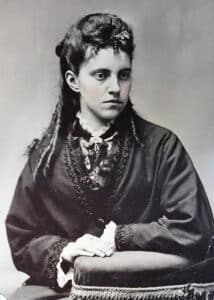
The tale of the Gunfight at the O.K. Corral would not be complete without Doc Holliday and his common-law wife, Katherine Harony. “Big Nose Kate,” as she was known, was a prostitute by choice. In her words, she didn’t want to belong to one man or one house. Paradoxically, she later became the long-time partner of the legendary gunslinger and gambler Doc Holliday. She is the only woman with whom Holliday is known to have had a relationship.
Doc proclaimed her an intellectual equal, although their relationship was volatile. Sadly, the constant fighting between the two almost resulted in Doc’s downfall.
After a particularly violent clash, enemies of Doc in Tombstone, Arizona, manipulated Kate into signing an affidavit implicating her partner in murder and attempted robbery. As a result, Judge Wells Spicer immediately issued an arrest warrant for Doc Holliday.
Following the trial, Doc tried to keep Kate away from Tombstone. However, fiery and stubborn as she was, Kate returned to his side during the final days before the shootout.
Many reporters tried to ask Kate about her life with Doc Holliday and about the shooting at the O.K. Corral, but since they didn’t want to pay anything, the story goes, she kept their knowledge to herself. A letter she wrote in 1889 contained some clues. There, she describes that she was with Doc Holliday in Fly’s Boarding House near the O.K. Corral until shortly before the shooting and that she witnessed the shooting.
Kate’s descriptions in this letter contain details that are consistent with the events through historical research, so her statements are considered credible.





Related posts: